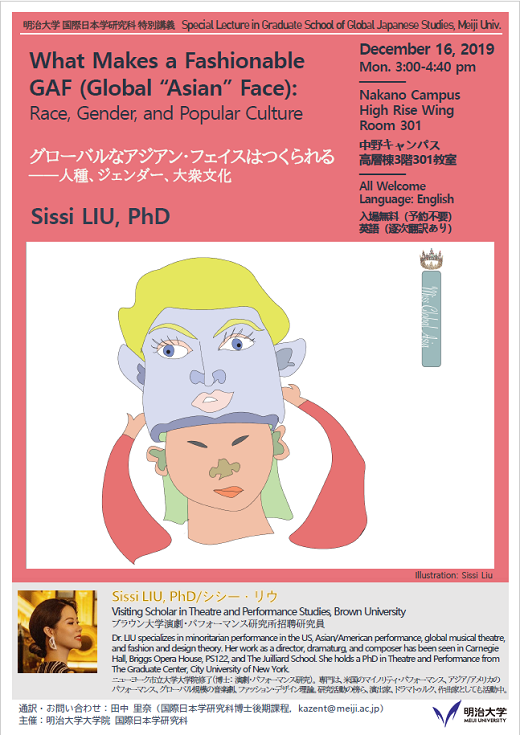国際日本学研究科 特別講義「グローバルなアジアン・フェイスはつくられる —人種、ジェンダー、大衆文化」開催のお知らせ
開催期間:2019年12月16日
明治大学 大学院国際日本学研究科
 特別講義「グローバルなアジアン・フェイスはつくられる——人種、ジェンダー、大衆文化」のチラシ
特別講義「グローバルなアジアン・フェイスはつくられる——人種、ジェンダー、大衆文化」のチラシ
国際日本学研究科では、この度、アメリカ合衆国ブラウン大学演劇・パフォーマンス研究所招聘研究員のシシー・リウ博士をお招きして、特別講義「グローバルなアジアン・フェイスはつくられる——人種、ジェンダー、大衆文化」を開講します(使用言語:英語、逐次通訳あり))。
学部生、学外の方も歓迎いたします。ぜひご参加ください(入場無料、予約不要)。
The Graduate School of Global Japanese Studies is pleased to present a special lecture “What Makes a Fashionable GAF (Global “Asian” Face): Race, Gender, and Popular Culture” by Dr. Sissi LIU (Visiting Scholar in Theatre and Performance Studies, Brown University, USA). The lecture will be conducted in English (with interpretation in Japanese).
This lecture is open to all graduate and undergraduate students, and others who are interested in the sociohistorical and technological conditions that made a fashionable “Asian” face” in global popular culture in the past decades.
「グローバルなアジアン・フェイスはつくられる—人種、ジェンダー、大衆文化」(チラシPDF)
Please find a flyer (PDF): “What Makes a Fashionable GAF (Global “Asian” Face): Race, Gender, and Popular Culture”
講師 Lecturer: シシー・リウ博士 / Dr. Sissi LIU
日時 Date & Time:
2019年12月16日(月)15:00~16:40 / December 16, 2019 (Mon), 3:00 pm – 4:40 pm
場所 Location:
明治大学 中野キャンパス 高層棟3階301教室 / Meiji University, Nakano Campus, High Rise Wing, Room 301
通訳 Interpreter: 田中 里奈(国際日本学研究科博士後期課程)/ Rina TANAKA (Graduate School of Global Japanese Studies, Doctoral Course)
【講義概要】(Please see below for the abstract in English)
20世紀半ばまで、西欧と北米におけるさまざまな大衆文化は、アジアン・フェイス(アジア風の顔つき)の典型的な人種的特徴を繰り返し強調してきた。このために、規範的なアジアン・フェイスは、二極の間で振り子のように揺れ動いている。すなわち一方では嘲笑の対象として——特に舞台上演におけるイエローフェイス——、そして他方では、稀有ではあるが、アジア人として初めて有名になったハリウッド女優アンナ・メイ・ウォン(1905-1961)のように、名声とファッションのアイコンとして。20世紀中葉以来、アジアン・フェイスに関する上記のような欧米の共通理解は、東アジアにおける、「洗練された」顔の増加現象と並行しており、これは典型的なアジア風およびコーカサス風の特徴をともに示している。欧米の美学的基準を反映したこれらの顔は、東アジアにおける以下のような事例——美容整形手術(いわゆる二重(ふたえ)整形や鼻梁整形)の流行や、メディアにおける東洋と西洋の、いわゆるハーフの芸能人の扱われ方——に顕著に現れている。
何が顔をアジアンにするのか。何がアジアン・フェイスをグローバル化するのか。洒脱なアジアン・フェイスを、何が、誰のために形作るのか。グローバルに流行するアジアン・フェイスの力の源は何なのか。 そして、アジアン・フェイスの、およびグローバルな大衆文化におけるその描写の進化——あるいは退化——の軌跡は、これまでどのように推移してきたのか。アジアン・フェイスとは、生得的なものに限られず、むしろ社会史的に、イエローフェイスや数多のその派生形を通じて捏造されたり、あるいは技術的に、化粧や整形手術によって造り出されたりもする。パフォーマンス・スタディーズ、アメリカ研究、批判的人種理論(critical race theory)、混人種学(mixed race studies)、大衆文化史を横断した学際的観点から、本講義では、ファッショナブルなアジアン・フェイスの形成を歴史的に追うとともに、理論的アプローチを提案する。前半では、アジアン・フェイスがどのように、ヨーロッパと北米で、および東アジアへ/からの循環の中で構築されてきたのかを、大まかに3つの時期に分けて点検する。後半では、規範化されたアジアン・フェイスの解体に関する様々な試みと、その背景にある理論的動機について追究していく。
Abstract
Before the mid-20th century, popular cultures in Western Europe and North America have highlighted the stereotypical racial features of the Asian face. A normative Asian face therefore oscillates between a subject of ridicule—particularly in yellowface performances—and, in rare cases, a site of fame and fashion, as exemplified by Anna May Wong (1905-1961). Since the mid-20th century, such common western perception of Asian face is paralleled by the phenomenon of increasingly fashionable and normative faces in East Asia that exhibit both stereotypical Asian and Caucasian features. Reflecting Euro-American aesthetic standards, these faces have rendered popular plastic surgical procedures of blepharoplasty (double eyelid surgery) and rhinoplasty (nose bridge reconstruction) as well as media appearances of Eurasian performers in East Asia.
What makes a face “Asian”? What makes an “Asian” face global? What constitutes a fashionable“Asian” face, and for whom? What gives power to a global fashionable “Asian” face? And what has been the trajectory of the evolution—or perhaps regression—of an “Asian” face and its portrayal in global popular culture? An “Asian” face is not always born, but rather sociohistorically fabricated through the practices of yellowface and its many variants, or technologically made using makeup or plastic surgery. Intersecting performance studies with American studies, critical race theory, mixed race studies, and popular culture history, this lecture historicizes and proposes a theoretical approach to the making of a fashionable “Asian” face. The first half of the talk examines how “Asian” faces were constructed primarily in Europe and North America and their circulation to and from East Asia in three loosely chronological stages. The second half of the talk explores the multifarious attempts of deconstructing the normative“Asian” face and the theoretical drive behind them.
【講師プロフィール】
Dr. シシー・リウ(Dr. Sissi LIU)
ブラウン大学演劇・パフォーマンス研究所招聘研究員。ニューヨーク市立大学大学院修了(博士:演劇・パフォーマンス研究)。専門は、米国のマイノリティ・パフォーマンス、アジア/アメリカのパフォーマンス、グローバル規模の音楽劇、ファッション・デザイン理論。査読付学術誌(『Asian Theatre Journal』、『Performance Research』、『Studies in Musical Theatre』)および複数の学術書(『The Routledge Handbook of Asian Theatre』、『iBroadway: Musical Theatre in the Digital Age』)へ寄稿。著書『Shapeshifter Consciousness, or Wukongism: How China’s Monkey King Offers Method for Minoritarian Performance in the US』では、アジア/アメリカのフォーマンスの理論形成に対する新たなアプローチを展開。研究活動の傍ら、演出家、ドラマトゥルク、作曲家として、カーネギー・ホール、ブリッグス・オペラ・ハウス、PS122、ジュリアード音楽院で作品を発表している。ロードアイランド・スクール・オブ・デザインでジュエリー・デザインを専攻し、デザイナーとしても活動中。www.SissiLiu.net
Dr. Sissi Liu is a visiting scholar in theatre and performance studies at Brown University. She specializes in minoritarian performance in the US, Asian/American performance, global musical theatre, and fashion and design theory. Her writing appears in peer-reviewed journals such as Asian Theatre Journal, Performance Research, Studies in Musical Theatre, as well as several books including The Routledge Handbook of Asian Theatre, and iBroadway: Musical Theatre in the Digital Age. Her book manuscript, Shapeshifter Consciousness, or Wukongism: How China’s Monkey King Offers Method for Minoritarian Performance in the US, explores new approaches of theorizing Asian/American performance. Her work as a director, dramaturg, and composer has been seen in venues such as Carnegie Hall, Briggs Opera House, PS122, and The Juilliard
School. Dr. Liu is also a practicing jewelry designer, trained at the Rhode Island School of Design. She holds a PhD in Theatre and Performance from The Graduate Center, City University of New York. www.SissiLiu.net
【主催】明治大学大学院国際日本学研究科


